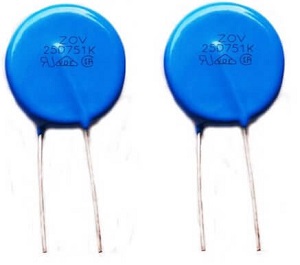A varistor is a semiconductor resistor with a symmetric non-linear volt-ampere characteristic. The name is derived from the words “variable resistor” – a resistor that changes.
It has the property of sharply decreasing its resistance when the applied voltage exceeds a certain threshold value. With further increase in voltage, the resistance decreases even more.
Principle of operation
The operating principle of a varistor is based on its non-linear symmetric volt-ampere characteristic, which allows it to function with both DC and AC voltage.
The varistor works by initially exhibiting high resistance to current flow at low voltages. However, as the voltage applied to the varistor increases beyond a certain threshold value, the resistance of the varistor decreases rapidly, allowing a significant current to pass through it. This occurs because the varistor is typically composed of a material with highly non-linear resistivity, such as metal oxide.
This decrease in resistance is due to the creation of a conductive path within the material.
The symbol for this component on schematics resembles a regular resistor, but with a diagonal line crossing it, where the letter U may be marked.
Varistors have a wide range of applications in protective devices, such as protection of communication lines, microprocessors, power sources, cable television, and other electronic circuits from overvoltage.
A varistor is installed in parallel with an electrical circuit for protection. Therefore, when a voltage pulse occurs in the protected circuit, the energy is not transmitted to the device, but instead dissipates in the varistor in the form of heat. If the energy of the pulse is too high, the varistor will burn out. A fuse is installed in series with the entire electrical circuit before the varistor. In the event of a strong voltage pulse and the varistor burning out, the fuse will also blow, breaking the electrical circuit.
Characteristics of varistors
The following parameters are typically used to describe the characteristics of varistors:
Un – nominal classification voltage. This is the operating voltage of the element, at which it passes a current of 1 mA.
Um~ – maximum AC and RMS voltage;
Um – maximum DC voltage. Range: from a few to several tens of kV, and may only be exceeded during overvoltage events.
P – nominal average power – the power in watts (W) that the varistor can dissipate over its entire service life while maintaining its parameters within specified limits.
Ipp – maximum impulse current (Peak Surge Current) in amperes (A), for which the rise time and pulse duration are specified;
W – maximum allowable energy absorbed (Absorption energy) in joules (J), when exposed to a single impulse;
Co – capacitance, measured in the closed state at a given frequency; depends on the applied voltage, when the varistor passes a large current, it drops to zero.



